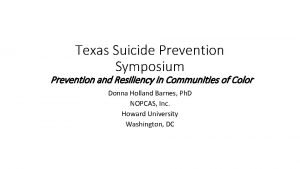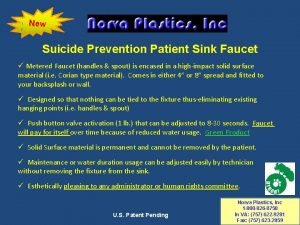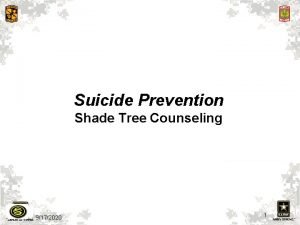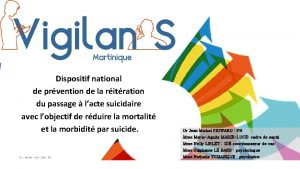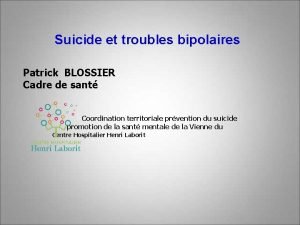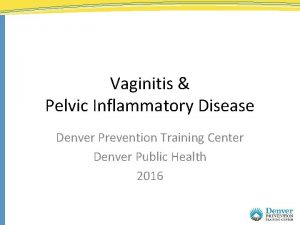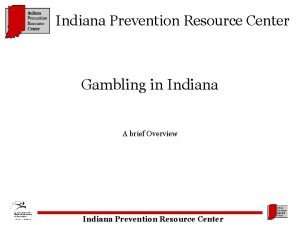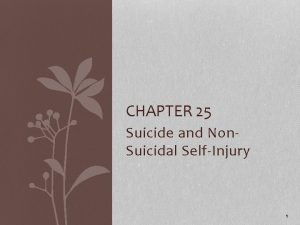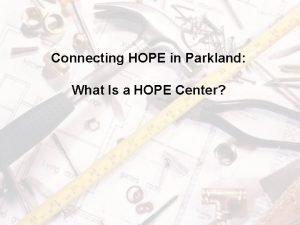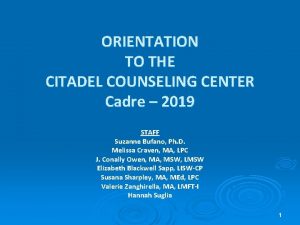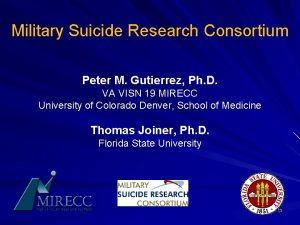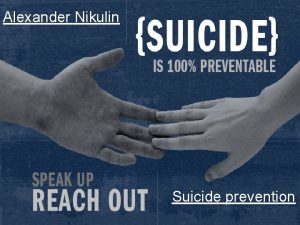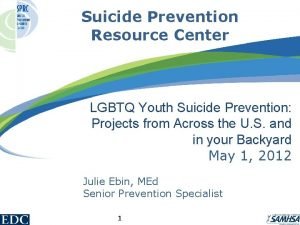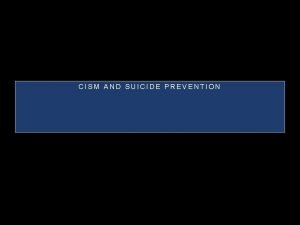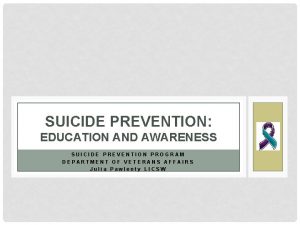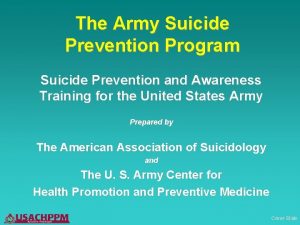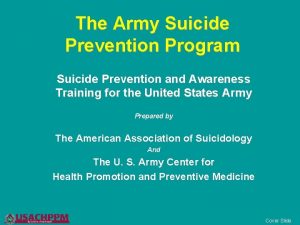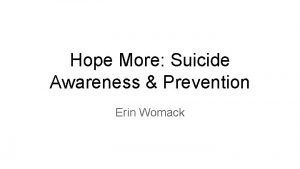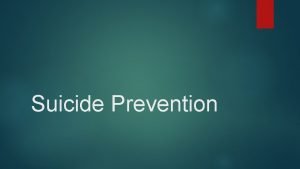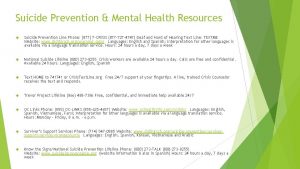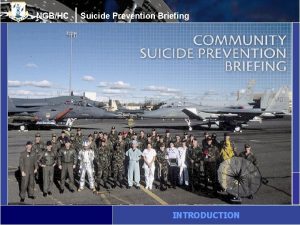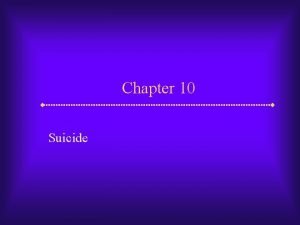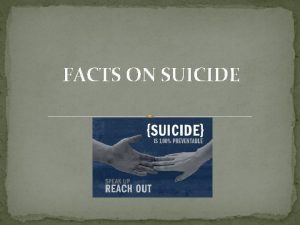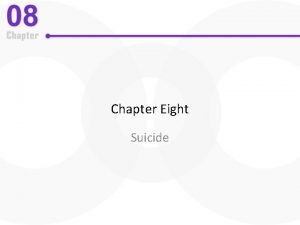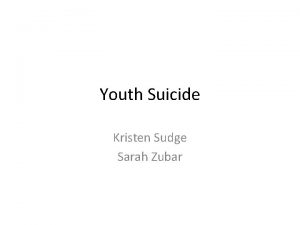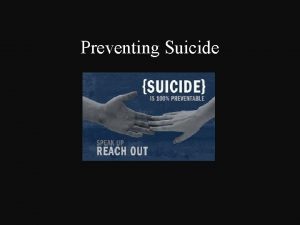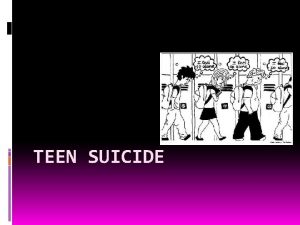Suicide Prevention Center There is hope and there






















- Slides: 22

Suicide Prevention Center There is hope and there is help

Suicide Prevention: Sickle Cell Desease, COVID-19 and Beyond

Suicide Statistics SUICIDE DEATHS: 2018* 10. 6 Million with Thoughts 1. 2 Million Attempts 48, 344 Suicides (SAMHSA, 2018) (Drapeau, 2020) • Do the numbers tell the full story? • 10 th leading cause of death in U. S. (Drapeau, 2020) • Highest rate of suicide amongst? (Drapeau, 2020) • Most lethal means? (Drapeau, 2020) • 59% of people who die by suicide do so during 1 st attempt (Bostwick 2016) • Anybody can be at risk To learn more about suicide statistics, visit www. suicidology. org Statistics from CDC and/or SAMHSA Study Suicide Prevention Center

Survivor Loss Statistics Research shows that during our lifetime: • 64% of us will know someone who attempts or dies by suicide (Cerel 2013) • 48% of us will personally know someone who dies by suicide (Cerel 2013) • 20% of us will identify as survivors of a loss to suicide (Cerel 2016) Suicide Prevention Center

The Evolution of Thoughts of Suicide What do you look forward to? What happens stresses whenyou stress out? piles up? I can’t see what’s on the other side! Mental Illness Loss Identity Family Work Suicide Prevention Center Financial Issues Health Relationships

The Brain & Tunnel Vision Hopelessness, helplessness Unbearable pain Mood congruent memory Preoccupation with death Suicide Prevention Center

Our Reaction Didi Hirsch Mental. Suicide Health Prevention Services/Suicide Center. Prevention Center

The Reaction They Need. . Suicide Prevention Center

What We’re Looking for in the Darkness Ambivalence Simultaneously having the desire to die and the desire to live Suicide Prevention Center

Suicide and Mental Illness 90% of people who die by suicide were struggling with mental illness Bi-polar Disorder Personality Disorders About 50% were not in treatment 60% have Depression Substance Abuse / Addiction Suicide Prevention Center Psychotic Disorders

Risk Factors: Increased Capability Behaviors & Characteristics Precipitating Factors, Recent Crisis, Stressors Family History, Prior Attempts and/or Ideation Suicide Prevention Center

Warning Signs: Invitations Present in 4 out of 5 suicides (80% of the time) Feelings / Affect Statements Behaviors Writings / Drawings/ Social Media Appearance Suicide Prevention Center

How Do You Help a Person at Risk? Most important thing to do if you think someone is at risk… ASK! “Are you thinking of killing yourself? ” Suicide Prevention Center

Components of Balancing Rapport lly Listen carefu (Moving away from painful topics) Express Concern and empathy (Offering immediate assurance) Identify feelings (Minimizing / Discounting) Take thoughts seriously Suicide Prevention Center

Step 2: Assess Risk Asking • Direct vs. Indirect • How to ask Suicide Prevention Center

Asking About Suicide • Have things gotten so hard that you’ve had thoughts of suicide? • “When you say ____, do you mean you are thinking of ending your life? ” • “Sometimes when people are going through ___, they can have thoughts of suicide. Is this something you’ve been thinking about? ” Suicide Prevention Center

Step 2: Assess Risk Asking Responding • Direct vs. Indirect • How to ask • With empathy and respect • Calmly Suicide Prevention Center

Responding About Suicide If the person says yes, be sure to say something empathetic before continuing the assessment … “I’m really glad you were able to share that with me. ” “You must be in so much pain. ” “I’m worried about you. ” Didi Hirsch Mental. Suicide Health Prevention Services/Suicide Center. Prevention Center

Step 2: Assess Risk Asking Responding Assessing • Direct vs. Indirect • How to ask • With empathy and respect • Calmly • Plan, means, timeline, gun • Scaling question Suicide Prevention Center

Step 3: Establish Safety For the Person at Risk Plan for safety Connect to resources Connect to support (friends/family) Ask to repeat back plan For yourself Consult/Debrief by calling SPC Self-care Suicide Prevention Center

Safety Planning App Suicide Prevention Center

SPC Resources • Suicide Prevention Hotline 1 -800 -273 -8255 • Survivors of Suicide Attempts 1 -424 -362 -2911 (Support groups for those who have attempted suicide) • Survivors After Suicide (Bereavement support groups) • Adults 1 -424 -362 -2912 • Teens 1 -424 -362 -2911 • Community Outreach 1 -424 -362 -2909 • Disaster Distress Helpline 1 -800 -985 -5990 • Text: “Talk. With. Us” to 66746 (Presentations, trainings, health fair attendance, etc) Suicide Prevention Center
 Primary prevention secondary prevention tertiary prevention
Primary prevention secondary prevention tertiary prevention Mad acronym suicide prevention
Mad acronym suicide prevention Chapter 5 glencoe health answers
Chapter 5 glencoe health answers Suicide prevention chain teach
Suicide prevention chain teach Texas suicide prevention symposium
Texas suicide prevention symposium Mental health faucets
Mental health faucets Army suicide prevention situational questions
Army suicide prevention situational questions Prévention du suicide
Prévention du suicide Suicide prevention month quotes
Suicide prevention month quotes Army suicide prevention training
Army suicide prevention training Vivien blossier
Vivien blossier Dr grace alfonsi
Dr grace alfonsi Indiana prevention resource center
Indiana prevention resource center The sad persons scale
The sad persons scale The second coming structure
The second coming structure Parkland hope center
Parkland hope center Hope rehab center thailand
Hope rehab center thailand The hope center
The hope center Hi everyone
Hi everyone Hope is being able to see light
Hope is being able to see light Suicide girls sara calixto
Suicide girls sara calixto The citadel counseling center
The citadel counseling center Youth suicide research consortium
Youth suicide research consortium




